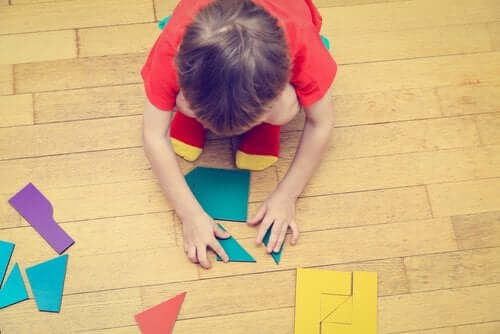Educate with Simplicity: Tips and Techniques

A child’s education is certainly a great responsibility for anyone who’s in charge of it, regardless of whether it’s the parents, grandparents, or teachers. Teaching children to have values, as well as how to be happy individuals, is a challenge. However, this shouldn’t always be synonymous with complexity since it’s totally feasible to educate with simplicity.
Many conditions will determine children’s character and behavior; family, friends and society will build their all-around education.
Children learn something new every second, even during gestation; the unconscious developing embryo begins to stimulate itself in response to the events of its surroundings, the maternal womb.
Educate with simplicity as early as possible
Children’s brains begin to gather useful information starting in the womb. The music the fetus listens to, the voice of his or her parents, the flashes of light and other stimuli will make the baby react in one way or another way, even after birth.
Because of this, we must make sure our children’s education is well-rounded, especially during the first years of their lives. To do this, you must address all areas of their educational development, in a simplified manner: perceptual, linguistic, physical, mental, emotional, and social.
This way, we won’t overwhelm the little ones; on the contrary, we’ll make them feel comfortable with the different activities derived from these approaches.

Help your child become a happy adult
Educating with simplicity will keep children away from the frustration and stress caused by strict and mandatory discipline. Even when setting limits, the way you do it will be the key to getting a proactive reaction.
Because of this, and many other reasons, the teaching methods applied at home and in schools have changed over time. They’ve adapted to improve the academic performance of each individual, allowing them to do their best in all areas and without pressure.
We must prioritize stimulating children’s potential in a simple way from the first stage of childhood.
Child brain stimulation
We can educate with simplicity by applying effective techniques from the moment they’re born. These techniques will allow us to stimulate children’s brains and establish habits that will improve their learning capacity.
Some techniques may seem so basic and common that many parents brush off the benefits that come with practicing them daily. However, they deserve that we dedicate more time to them. Some of these techniques include:
Reading technique
Reading to children from an early age will help improve their memory, boost thinking, and stimulate language. This won’t only allow them to develop their narrative and visual comprehension, but they’ll also create a special bond with the person who reads to them.
“Children learn something new every second, even during gestation. The unconscious developing embryo begins to stimulate itself in response to the events of its surroundings.”
Feeling every footstep
The soles of our feet have thousands of nerve endings that cause children to experience different sensations when walking on various types of soil. By doing this, they also stimulate the development of their brain.
The custom of walking barefoot has been lost nowadays because parents fear that their little ones will get sick. But in reality, it’s very beneficial for them, as long as we take into account all relevant safety and hygiene measures.
Empower thinking through puzzles
One way to educate with simplicity is by using puzzles, as they stimulate children’s brain development. These games, as well as legos, enhance children’s fine motor skills, as well as their visual perception and coordination.

When we use this type of technique for stimulating our children, we must make sure that the puzzles are suitable for their ages. That way, we avoid generating episodes of frustration when they aren’t able to complete it due to its complexity.
These techniques promote children’s overall education and stimulate their development. Besides, when we educate with simplicity, there’s no need to expose them to intense doses of stress.
Remember that childhood is the most crucial time for us to shape our children to become competent adults. We’ll achieve this if we have character, establish clear rules, teach values, and have much love. These are the essential ingredients to educate with simplicity.
A child’s education is certainly a great responsibility for anyone who’s in charge of it, regardless of whether it’s the parents, grandparents, or teachers. Teaching children to have values, as well as how to be happy individuals, is a challenge. However, this shouldn’t always be synonymous with complexity since it’s totally feasible to educate with simplicity.
Many conditions will determine children’s character and behavior; family, friends and society will build their all-around education.
Children learn something new every second, even during gestation; the unconscious developing embryo begins to stimulate itself in response to the events of its surroundings, the maternal womb.
Educate with simplicity as early as possible
Children’s brains begin to gather useful information starting in the womb. The music the fetus listens to, the voice of his or her parents, the flashes of light and other stimuli will make the baby react in one way or another way, even after birth.
Because of this, we must make sure our children’s education is well-rounded, especially during the first years of their lives. To do this, you must address all areas of their educational development, in a simplified manner: perceptual, linguistic, physical, mental, emotional, and social.
This way, we won’t overwhelm the little ones; on the contrary, we’ll make them feel comfortable with the different activities derived from these approaches.

Help your child become a happy adult
Educating with simplicity will keep children away from the frustration and stress caused by strict and mandatory discipline. Even when setting limits, the way you do it will be the key to getting a proactive reaction.
Because of this, and many other reasons, the teaching methods applied at home and in schools have changed over time. They’ve adapted to improve the academic performance of each individual, allowing them to do their best in all areas and without pressure.
We must prioritize stimulating children’s potential in a simple way from the first stage of childhood.
Child brain stimulation
We can educate with simplicity by applying effective techniques from the moment they’re born. These techniques will allow us to stimulate children’s brains and establish habits that will improve their learning capacity.
Some techniques may seem so basic and common that many parents brush off the benefits that come with practicing them daily. However, they deserve that we dedicate more time to them. Some of these techniques include:
Reading technique
Reading to children from an early age will help improve their memory, boost thinking, and stimulate language. This won’t only allow them to develop their narrative and visual comprehension, but they’ll also create a special bond with the person who reads to them.
“Children learn something new every second, even during gestation. The unconscious developing embryo begins to stimulate itself in response to the events of its surroundings.”
Feeling every footstep
The soles of our feet have thousands of nerve endings that cause children to experience different sensations when walking on various types of soil. By doing this, they also stimulate the development of their brain.
The custom of walking barefoot has been lost nowadays because parents fear that their little ones will get sick. But in reality, it’s very beneficial for them, as long as we take into account all relevant safety and hygiene measures.
Empower thinking through puzzles
One way to educate with simplicity is by using puzzles, as they stimulate children’s brain development. These games, as well as legos, enhance children’s fine motor skills, as well as their visual perception and coordination.

When we use this type of technique for stimulating our children, we must make sure that the puzzles are suitable for their ages. That way, we avoid generating episodes of frustration when they aren’t able to complete it due to its complexity.
These techniques promote children’s overall education and stimulate their development. Besides, when we educate with simplicity, there’s no need to expose them to intense doses of stress.
Remember that childhood is the most crucial time for us to shape our children to become competent adults. We’ll achieve this if we have character, establish clear rules, teach values, and have much love. These are the essential ingredients to educate with simplicity.
All cited sources were thoroughly reviewed by our team to ensure their quality, reliability, currency, and validity. The bibliography of this article was considered reliable and of academic or scientific accuracy.
- CATAUDELLA, E. Simplicity Parenting. http://www.imfcanada.org/sites/default/files/eReview_Feb_5_15.pdf
- Cherry, K. (2012). Parenting styles. The Four Styles of Parenting. https://locallocale.wordpress.com/2011/05/11/whats-parenting-style-got-to-do-with-it/
This text is provided for informational purposes only and does not replace consultation with a professional. If in doubt, consult your specialist.








